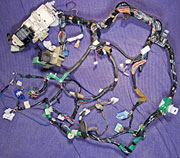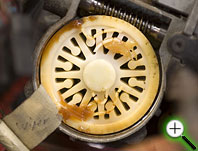Well-Grounded · 12 December 05

Eve had a little bit of her wiring reworked over the weekend.
Hmm, actually it was more like:
Wiring, beeping, de-wiring, beeping, wiring, beeping, de-wiring, wiring, beeping, de-wiring, beeping, wiring…
Beeping being the sound the voltmeter makes when there’s a shorted connection. In this case it was beeping out a short between chassis and system ground.
Lot’s of bleeping beeping.
As I mentioned earlier the inside wiring harness has been put back together and dressed. Well, if you can call being wrapped in black electrical tape as being “dressed up” then this is your kind of date.
Calling it a wiring harness isn’t quite right either. It’s really the central nervous system of the car’s electrical system with most of the fuses, some relays, and all of the interconnects between engine, dash, and chassis wiring.
Here’s how it looks now:

As a reminder, the image on the right is how the harness looked when it and the dash were first removed. Click the image for a larger version.

I’m feeling pretty happy about all of the stuff removed. It started off with over 30 connectors, which have been whittled down to about a dozen and an equally impressive pile of wires removed.
The last connector to be removed was an oddball grounding block. You can’t quite see it in the picture above, but there’s a about five ground wires just hanging off into space along the top edge in the middle. They were spliced into one thicker wire and a smaller wire which then went to the far right of the dash area and were grounded to the chassis.
There’s a bunch of grounding blocks scattered around the car, most of them look like this.

The block, as you can see, is just a bunch of connectors jammed onto a multi-headed jack that is then screwed to the chassis.
In looking at the Probe’s wiring manual there’s around six pages of grounding and quite a few of these blocks. Basically instead of running heavy duty ground wire throughout the system there’s smaller ground wires for most uses and then when you have heavier duty grounding needs (i.e. headlights) the ground goes straight to one of these blocks.
In fact there is no wire going from the battery ground to any of these system grounds. The battery ground is bolted to the chassis and to the transmission (providing ground to engine).
Someone wrote in the comments that I should re-wire the whole car to ensure that the ground is isolated from the chassis. I think they meant keeping the high voltage ground from the chassis with system ground. You don’t want the high voltage ground to be connected to the car’s normal ground, that’s why we use DC-to-DC converters and other steps. Bob Brant’s book covers this.
You could isolate the car’s normal ground as well, just to be doubly sure but I suspect that would make things more vunerable to static. Getting in and out of your car, especially in the winter, generates a lot of static. If you isolate the system ground you probably increase the chance of zapping electronics with stray static.
Still, I decide to explore how hard it would be to isolate ground. Removed all of the grounding blocks from the chassis…beep. Disconnected all of the wiring harnesses…beep. Turns out the headlight motors must be grounded to chassis where I can’t see. Unplug the connector, less resistance, still beep.

I was running out of things to unplug when I noticed the windshield wiper motor. Unplug the connectors…no beep.
The unit has two plugs and only one of them caused the grounding. So I took that section apart out of curiosity.
This is a switch cam. Basically as the motor turns this plastic wheel is spun around and an “arm” on the switch assembly (below) follows the channels in the cam. The motor turns until the switch is engaged, which probably reverses the motor polarity voltage and causes the motor to go the other way.
It flip flops better than a politician around election time.

I’ve highlighted the culprit for you. Somewhere in the switch box the ground is shunted over to this little metal contact, which gets pinched against the metal body of the wiper rig, which of course is bolted to the body.
After clearing that up and hooking the harness back up there were more bleeping shorts.
Inside the top of the hatchback one of the ground wires is bolted to metal, and another ground is bolted near the latch.
All in all I was eventually able to isolate ground entirely, but to really do this you need to replace all of the chassis grounds with a heavy duty ground wire, run throughout the car. I’ll stick with the chassis ground. It worked in the first EV and should be fine for Eve as well.



So, do you have a date in mind for the first powered trip down the road?
How much weight are you really saving with all of this electrical work it seems to be a lot of work. Do you think it is worth it? P.S. I will probably be doing the same on my conversion truck.
Hi spiral,
Depends on how complete I want it to be before driving. We’ve been planning on getting her painted. If it stays more or less the same color I suppose that can happen after the fact. If not then it would probably be easier and better looking if I did it before putting all of the guts back in. That sounds like a hassle…so probably red. ”:^)
Spring? Not really in a hurry to get her on the road in the middle of winter since the roads are all covered in salt.
Hey Ed,
None! Ok, maybe a little bit but certainly not enough to justify any of this mess.
No, the main reasons for doing this are:
– curiosity (it has been educational)
– “owning” the wiring
On the first EV I wasn’t sure what all of the old wires were, what to remove, etc.. so I pretty much left it alone.
The problem was that the system battery would sometimes discharge on its own. I’d put an ammeter on it but could never track down what the problem was. Since I didn’t understand the electrical system it was always a black box.
With Eve I know where everything goes and what it does. No mysteries.
Wasn’t satisfied with the alignment between E-motor and tranmission. At 4000+ RPM this needs to be very tight. This weekend I turned a new alignment tool which uses the pilot shaft of the tranmission as inner diameter (instead of the coupling) Much better alignment (within a few thousandths) Also I used locater pins to firm the alignment to the bell housing. Much better than relying on bolt holes to align (bolt holes typically have at least 1/64 slop. Misalignment could shorten life of motor bearings and transmission seal. I have the tool if you would like to borrow and your input shaft is same diameter. I’ll send pictures along with my heater core, as soon as I figure out how to get them out of the digital camera and into an e-mail.
If the battery would discharge that would be reason enough to want to want to redo the entire system. I assume with this system you will not have a systam battery everything will be tied into the battery pack.
Looking forward to your email/update, Woody.
That’s one choice Ed. I’ll post an article at some point that discusses the various options.
Even into the late 1960s, I remember cars having “positive ground” (or “positive earth” in English cars). All of them eventually came around because of several reasons: 1) less chance of reversing polarity when jump starting from a differently wired car; 2) more standardized parts (radios, starters, etc.) and; 3) positive ground seemed to exacerbate electrolysis in car bodies (already a problem because of brazing and dissimilar metals).
Electrical components are much more water tight now and so don’t tend to create ground loops through puddles in the body, so I don’t think there is much electrolysis anymore, but maybe it’s still a reason to use a negative ground.
Then there were the 6-volt cars, but that’s another story…
Yup, until last year I had a Hillman SuperMinx from 1962. That was positive earth. I’ve sold it now and the new owner uses it for period TV work. It’s still possible to get all the pos earth parts. I had to get a new dynamo and voltage regulator for it 2 years ago.
Hey Jerry, Great job on the car, i’m just catching up on your saga. I was wondering if you could give a little more detail on your opinion of Bob Brant’s book. I find it very technical and off the point. The equations of all sorts of non-sense are well, non-sense!! What can I use from this book, more precisely what part do you reference to in your article?